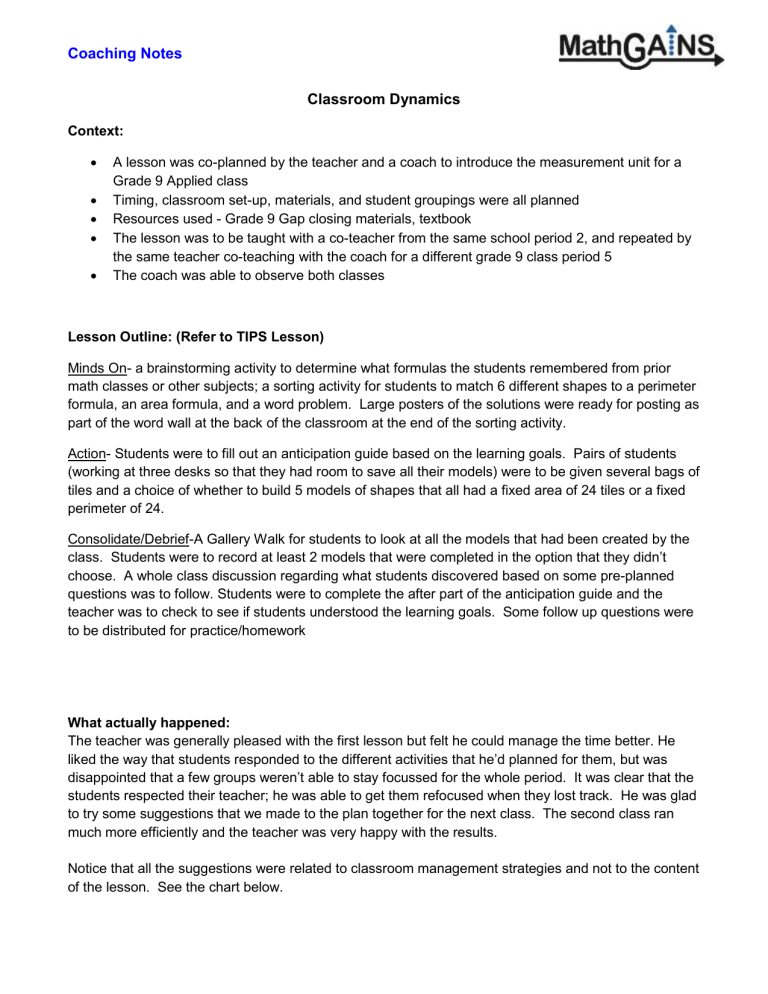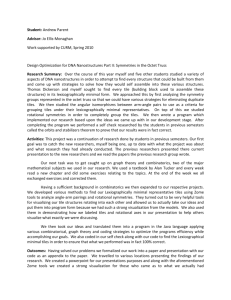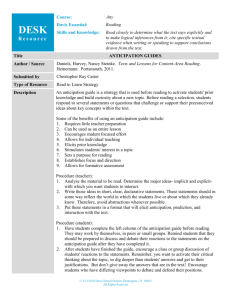Classroom Dynamics Example

Coaching Notes
Classroom Dynamics
Context:
A lesson was co-planned by the teacher and a coach to introduce the measurement unit for a
Grade 9 Applied class
Timing, classroom set-up, materials, and student groupings were all planned
Resources used - Grade 9 Gap closing materials, textbook
The lesson was to be taught with a co-teacher from the same school period 2, and repeated by the same teacher co-teaching with the coach for a different grade 9 class period 5
The coach was able to observe both classes
Lesson Outline: (Refer to TIPS Lesson)
Minds On- a brainstorming activity to determine what formulas the students remembered from prior math classes or other subjects; a sorting activity for students to match 6 different shapes to a perimeter formula, an area formula, and a word problem. Large posters of the solutions were ready for posting as part of the word wall at the back of the classroom at the end of the sorting activity.
Action- Students were to fill out an anticipation guide based on the learning goals. Pairs of students
(working at three desks so that they had room to save all their models) were to be given several bags of tiles and a choice of whether to build 5 models of shapes that all had a fixed area of 24 tiles or a fixed perimeter of 24.
Consolidate/Debrief-A Gallery Walk for students to look at all the models that had been created by the class
. Students were to record at least 2 models that were completed in the option that they didn’t choose. A whole class discussion regarding what students discovered based on some pre-planned questions was to follow. Students were to complete the after part of the anticipation guide and the teacher was to check to see if students understood the learning goals. Some follow up questions were to be distributed for practice/homework
What actually happened:
The teacher was generally pleased with the first lesson but felt he could manage the time better. He liked the way that students responded to the different activities that he’d planned for them, but was disappoi nted that a few groups weren’t able to stay focussed for the whole period. It was clear that the students respected their teacher; he was able to get them refocused when they lost track. He was glad to try some suggestions that we made to the plan together for the next class. The second class ran much more efficiently and the teacher was very happy with the results.
Notice that all the suggestions were related to classroom management strategies and not to the content of the lesson. See the chart below.
Coaching Notes
Classroom Dynamics situation in first
Situation #2: class
Situation #1:
When students arrived, they saw the three desks and self-selected into groups of three. Teacher said “I wanted you in your normal groups of two”; students groaned, teacher reflected “okay, I think this will work.” The teacher demonstrated flexibility but the groupings weren’t as effective as the ones he’d originally planned.
The brainstorm task – students didn’t remember any formulas and the teacher spent too much time trying to encourage them, without success. As a result the two-minute task took seven minutes
Suggested adjustment – planned in collaboration: teacher, coteacher, coach
Keep the students in the groups of two that had been planned.
Set them up as students come in the door.
Start them off with one example and allow 2 minutes for brainstorm. If the students don’t remember any formulas, move on since they’ll be getting some during the sorting activity and in this unit.
Situation #3:
The sorting task – the teacher’s instructions were very open: “put the cards from the envelope into six different piles.” As a result, the kids didn’t understand what the sorting criteria was and it took the teacher about five minutes to visit all the groups to get them started. The students eventually became engaged in the activity but a ten minute task took 20+ minutes. Also, because the students were in groups of three one of the students had difficulty reading the cards so that student was not very involved in the sorting task.
Provide clear written instructions for the students. Show them one of the examples created for the word wall.
(Scaffolding suggestion for pairs having difficulty: place the shapes at the top of the desk; read the formulas and place all the ones you are sure of first and then deal with what’s left)
Stick to 10 minutes; post the answers during the last two minutes of the activity so students can check results if they are finished or confused. No other take up will be needed since these will remain posted during the unit.
Result of adjustment in second class
Teacher was at the door as students came in and controlled the groups even when they tried to form their own. Pairs worked well for this lesson. The students were very cooperative.
Teacher started them off with an example, announced that they would have 1 minute with their partner to come up with as many as they could.
Then he would ask each group for one of their examples. The teacher stuck to the time; students had a hard time remembering formulas so only a few groups were able to provide any examples. This took two minutes.
Clear instructions were written on the board, an example was posted at the back. The teacher reviewed both and let them sort. They were very engaged. He called a two minutes left as he posted the solutions and students did check or took over their left over pieces to see where they fit. They did this on their own. This took ten minutes.
Coaching Notes
Situation #4
The tile activity –The teacher handed out the anticipation guide and the tiles at the same time before he gave any instructions. The teacher then had to get the students to stop playing with the tiles with some success before he could get them to fill in the anticipation guide and give them instructions for their task. It took a while before the kids really got going but they were very engaged when they did. Many of the students hadn’t heard that they were supposed to save all their models for others to see so some groups only ended up with one or two models to share. The teacher wished he’d had more time for this activity because the kids really worked hard at it but ran out of time.
Situation #5
The Gallery Walk – the teacher asked the kids to go on a gallery walk and record two examples from the option that they didn’t do. The students had never been on a gallery walk before so they just walked around the room superficially without really thinking about the math they were seeing, and having very social conversations. When the walk concluded the teacher debriefed with the whole class using the anticipation guide. Some very insightful statements were made by several students but they were lost on many students because they were continuing to socialize. The teacher didn’t feel that he’d gone deeply enough to assign the practice and homework he’d been planning.
Using the document camera show an example of the task using only 12 tiles so the students have a context for the anticipation guide and the task’s two options.
Tell students that they must save all their models, this is why they have the extra desk.
Hand out the tiles after they have completed the anticipation guide.
Allow about 40 minutes for this task.
Ask students to explain their thinking as you wander from group to group, probe for understanding.
Run the Gallery Walk with the teacher as tour guide so that the task can be debriefed at each station depending on how the groups created their models.
Teacher made the adjustments suggested. When they got their bags of tiles they started working on their models right away. They were very engaged in the task.
They worked at it for 40 minutes.
Teacher was a great tour guide and he planned his route very strategically. Once again students made some very insightful statements but this time it resulted in some
“aha’s” for other students.
Although the teacher was pleased with both lessons, he felt that by paying attention to classroom dynamic, he was able to go deeper with the second class.
Since this is a full year school he will be delivering the lesson again with a third class next day.









